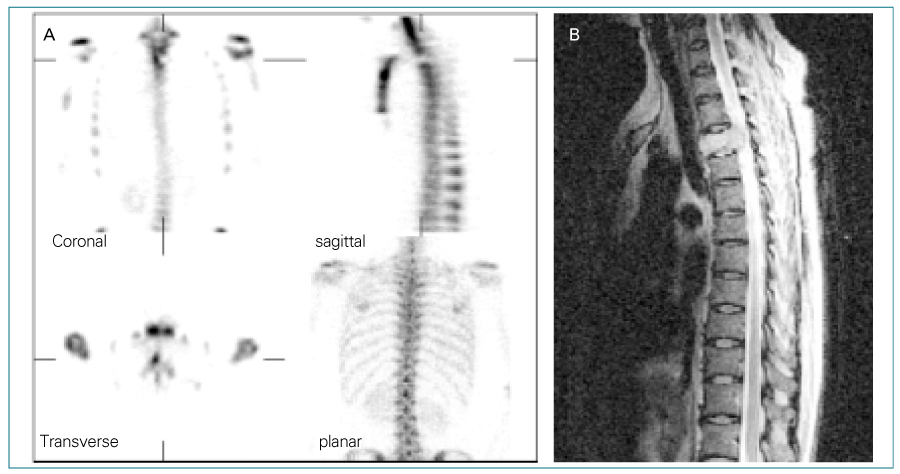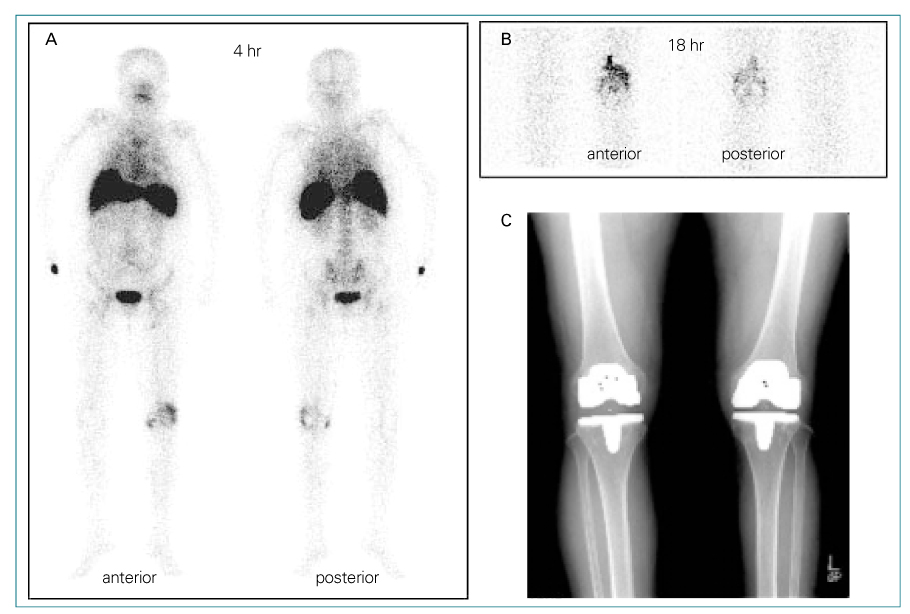J Korean Med Assoc.
2003 Mar;46(3):196-203. 10.5124/jkma.2003.46.3.196.
Recent Advances in Musculoskeletal Nuclear Medicine
- Affiliations
-
- 1Department of Nuclear Medicine, University of Ulsan College of Medicine, Asan Medical Center, Korea. dhmoon@amc.seoul.kr, jsryu2@amc.seoul.kr
- KMID: 1958055
- DOI: http://doi.org/10.5124/jkma.2003.46.3.196
Abstract
- Bone scintigraphy with 99mTc-methylene diphosphonate is the most frequently performed procedure in routine nuclear medicine practice in Korea. Bone scintigraphy is an extremely sensitive procedure for evaluating a variety of skeletal disorders and has the advantages of whole body evaluation. The main indications for referral include screening of patients with malignancy, trauma, orthopedic problems, sports injuries, as well as endocrine and rheumatologic disorders. Recent advances in instrumentation and the subsequent improvement in image quality have allowed nuclear medicine physicians to provide more accurate bone scan interpretations. The unique diagnostic information provided by SPECT and new indications of bone scintigraphy have emerged. There is an increasing opportunity to use PET imaging with 18F or 18F-fluorodeoxyglucose for the evaluation of musculoskeletal diseases. The application of new radiopharmaceuticals has provided information on changes in pathophysiological and pathobiochemical process and allowed more specific diagnosis, particularly for infection and tumors. The correlative image interpretation with results of other nuclear medicine or radiological imaging modalities is important. The image registration using software or hardware fusion will provide a higher degree of diagnostic accuracy. The role of bone scintigraphy is still expanding and will remain as one of the most commonly performed nuclear medicine procedures because of its sensitivity, simplicity, and cost-effectiveness. With advances of new imaging technology and radiopharmaceuticals, the diagnostic algorithm should be reestablished.
Keyword
MeSH Terms
Figure
Reference
-
2. Collier BD Jr, Hellman RS, Krasnow AZ. Bone SPECT. Semin Nucl Med. 1987. 17:247–266.
Article3. Even-Sapir E, Martin RH, Barnes DC, Pringle CR, Iles SE, Mitchell MJ. Role of SPECT in differentiating malignant from benign lesions in the lower thoracic and lumbar vertebrae. Radiology. 1993. 187:193–198.
Article4. Savelli G, Maffioli L, Maccauro M, De Deckere E, Bombardieri E. Bone scintigraphy and the added value of SPECT (single photon emission tomography) in detecting skeletal lesions. Q J Nucl Med. 2001. 45:27–37.5. Robinson LA. Radio-guided surgical biopsy for the diagnosis of suspected osseous metastases. Q J Nucl Med. 2001. 45:38–46.6. Krasnow AZ, Hellman RS, Timins ME, Collier BD, Anderson T, Isitman AT. Diagnostic bone scanning in oncology. Semin Nucl Med. 1997. 27:107–141.
Article7. Cook GJ, Houston S, Rubens R, Maisey MN, Fogelman I. Detection of bone metastases in breast cancer by 18FDG PET: differing metabolic activity in osteoblastic and osteolytic lesions. J Clin Oncol. 1998. 16:3375–3379.
Article8. Bury T, Barreto A, Daenen F, Barthelemy N, Ghaye B, Rigo P. Fluorine - 18 deoxyglucose positron emission tomography for the detection of bone metastases in patients with non-small cell lung cancer. Eur J Nucl Med. 1998. 25:1244–1247.
Article9. Pneumaticos SG, Chatziioannou SN, Moore WH, Johnson M. The role of radionuclides in primary musculoskeletal tumors beyond the 'bone scan'. Crit Rev Oncol Hematol. 2001. 37:217–226.
Article10. Schirrmeister H, Glatting G, Hetzel J, Nussle K, Arslandemir C, Hetzel M, et al. Prospective evaluation of the clinical value of planar bone scans, SPECT, and (18)F-labeled NaF PET in newly diagnosed lung cancer. J Nucl Med. 2001. 42:1800–1804.11. Becker W, Meller J. The role of nuclear medicine in infection and inflammation. Lancet Infect Dis. 2001. 1:326–333.
Article12. Love C, Tomas MB, Marwin SE, Pugliese PV, Palestro CJ. Role of nuclear medicine in diagnosis of the infected joint replacement. Radiographics. 2001. 21:1229–1238.
Article13. Palestro CJ, Roumanas P, Swyer AJ, Kim CK, Goldsmith SJ. Diagnosis of musculoskeletal infection using combined In-111 labeled leukocyte and Tc - 99m SC marrow imaging. Clin Nucl Med. 1992. 17:269–273.
Article14. Britton KE, Wareham DW, Das SS, Solanki KK, Amaral H, Padhy AK, et al. Imaging bacterial infection with (99m)Tc-ciprofloxacin (Infecton). J Clin Pathol. 2002. 55:817–823.
Article15. Zhuang H, Alavi A. 18 - Fluorodeoxyglucose positron emission tomographic imaging in the detection and monitoring of infection and inflammation. Semin Nucl Med. 2002. 32:47–59.
Article16. Kanstrup IL. Bone scintigraphy in sports medicine: a review. Scand J Med Sci Sports. 1997. 7:322–330.
Article17. Bellah RD, Summerville DA, Treves ST, Micheli LJ. Low-back pain in adolescent athletes: detection of stress injury to the pars interarticularis with SPECT. Radiology. 1991. 180:509–512.
Article18. Ryu JS, Kim JS, Moon DH, Kim SM, Shin MJ, Lee HK, et al. Bone SPECT is more sensitive than MRI in the detection of early osteonecrosis of the femoral head after renal transplantation. J Nucl Med. 2002. 43:1006–1011.19. Blake GM, Park-Holohan SJ, Cook GJ, Fogelman I. Quantitative studies of bone with the use of 18F-fluoride and 99mTc-methylene diphosphonate. Semin Nucl Med. 2001. 31:28–49.
Article20. Bocher M, Balan A, Krausz Y, Shrem Y, Lonn A, Chisin R, et al. Gamma camera - mounted anatomical x-ray tomography: technology, system characteristics and first images. Eur J Nucl Med. 2000. 27:619–627.
Article21. Beyer T, Townsend DW, Brun T, Kinaham PE, Charron M, Nutt R, et al. A combined PET/CT scanner for clinical oncology. J Nucl Med. 2000. 41:1369–1379.




